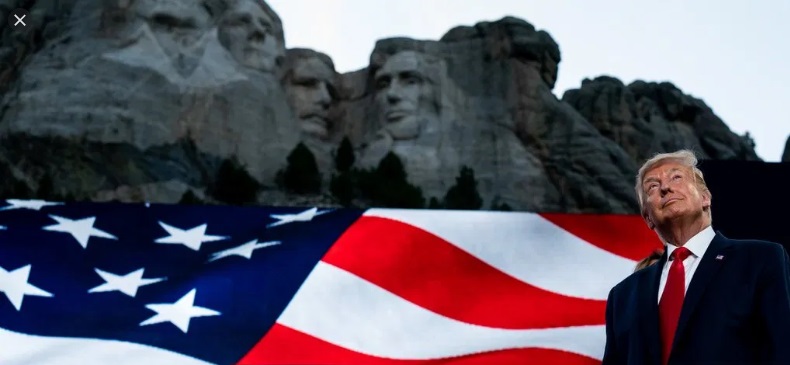Historians have weighed in on Trump’s picks for his new National Garden of American Heroes, branding the Trump’s choices as ‘odd’ and ‘inappropriate’, amid nationwide protests calling for the toppling of Confederate statues.
During a rabble-rousing speech at Mount Rushmore on Friday, Trump announced an executive order to create the new monument honoring ‘the greatest Americans who ever lived.’
The memorial, described as a ‘vast outdoor park’, will include statues of the likes of George Washington, Ronald Reagan, Martin Luther King, Jr., Harriet Tubman, Amelia Earhart and a number of army generals.
Trump, for the most part, steered clear of any overtly controversial choices, but the list has been criticized for its ‘random’ selection of people, the exclusion of Latinos and Native Americans, and the politically tone deaf timing of the move.
It comes as protesters are calling for the removal of statues, mostly those of Confederate generals and leaders, in light of recent demonstrations over racial injustice.
Karen Cox, a history professor at University of Carolina, Charlotte said the creation of a new monument does not address the current issues of race plaguing the country.
‘It’s just so random. It’s like they threw a bunch of stuff on the wall and just went with whatever stuck,’ she told the Washington Post. ‘Nothing about this suggests it’s thoughtful.’
Although most people would recognize most people on the list as influential historical figures, experts highlighted a few problematic picks.
Out of the 30 selections, only five are African American, none are Latino nor Native American, and not a single Democratic president made it to the list.
Some questioned Trump’s choice of Daniel Boone, a frontiersman who fought wars against Native Americans, and the more obscure Joshua Lawrence Chamberlain, a Union officer in the Civil War.
Historian Adam Domby said Trump appeared to have played it safe in his choices for black Americans which included Martin Luther King, Jr., Harriet Tubman, Booker T. Washington, Jackie Robinson, and Frederick Douglass.
‘It raises so many odd historical questions,’ he told the Post.
‘They include some African Americans, but only ones that might be considered “safe” or “comfortable” like Jackie Robinson and Martin Luther King Jr. Where’s W.E.B. Dubois? Where’s Malcolm X?’
Others also suggested the executive order seems like an attempt to mobilize the president’s political base ahead of the election, after he ordered the taskforce to submit a report detailing the plans and location for the garden within 60 days.
‘There’s no rush here. The only real emergency is that there’s an election coming up,’ James Grossman, executive director of the American Historical Association said.
Grossman said the choices varied from ‘odd to probably inappropriate to provocative.’
Journalist Douglas Blackmon criticized the executive order on Twitter, questioning Trump’s lack of response to the vandalism of monuments belonging to Civil War heroes.
‘If Trump believes so strongly in history and statues and memorials, start with protecting Civil Rights era true heroes from desecration and vandalism. And how about a national monument to opponents of southern secession? And to abolitionists?’ he said.
Names that may court controversy include Justice Antonin Scalia, who died in 2016, a conservative Supreme Court judge.
There is no liberal counterpart named on the list.
Republican president Ronald Reagan is also the only modern-day president on the list, excluding Democrats Franklin D. Roosevelt, Harry Truman, John F. Kennedy and Lyndon B. Johnson.
Trump’s new executive order calls for the park to include statues of the following Americans:
John Adams, second US president
Susan B. Anthony, leader of the women’s suffrage movement
Clara Barton, nurse and founder of the American Red Cross
Daniel Boone, American pioneer
Joshua Lawrence Chamberlain, Civil War Union colonel
Henry Clay, US Secretary of State under John Adams
Davy Crockett, US frontiersman
Frederick Douglass, abolitionist leader during Civil War
Amelia Earhart, first woman to fly across the Atlantic Ocean
Benjamin Franklin, US Founding Father and inventor
Billy Graham, evangelist
Alexander Hamilton, US Founding Father
Thomas Jefferson, US Founding Father and third president
Martin Luther King, Jr., civil rights leader and minister
Abraham Lincoln, 16th US president
Douglas MacArthur, WWII Army general
Dolley Madison, US first lady and wife of James Madison
James Madison, fourth US president and Founding Father
Christa McAuliffe, astronaut
Audie Murphy, WWII hero
George S. Patton, Jr., WWII Army general
Ronald Reagan, 40th US president
Jackie Robinson, first African American MLB player
Betsy Ross, designer of first American flag
Antonin Scalia, Supreme Court Justice
Harriet Beecher Stowe, abolitionist and author of Uncle Tom’s Cabin
Harriet Tubman, abolitionist and leader of Underground Railroad
Booker T. Washington, prominent African American educator and leader during Jim Crow era
George Washington, first US president
Orville and Wilbur Wright, inventors of world’s first motor-powered airplane
According to an Executive Order issued by the White House Friday, the garden should be completed and open for public access before the 250th anniversary of the proclamation of the Declaration of Independence on July 4, 2026.
The site it will be built on has yet to be revealed but will be ‘a site of natural beauty that enables visitors to enjoy nature, walk among the statues, and be inspired to learn about great figures of America’s history’.
